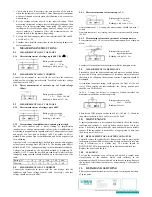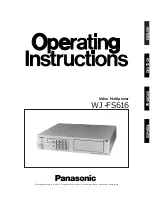
MI 7056
APPLICATION INSTRUCTIONS
1.
GENERAL DESCRIPTION
Due to small dimensions and electrical characteristics the MI 7056
multimeter is intended for a wide range of users. It is especially
convenient for service workshops where electrotechanical and radio-
television apparatuses are repaired. Its main advantage is a large
choice of measuring ranges as well as high input resistance. It is
possible to measure DC and AC voltages and currents, amplification
or weakening on four-poles and resistance. Measuring wires and
connection sockets are safe. A rubber border increases mechanical
resistance of the instrument, and makes the instrument user-friendly.
2.
TECHNICAL DATA
•
ratings: 23
•
length of basic scales:
approx. 87 mm
•
pointer tilt:
0 … 100
°∠
•
accuracy class:
2.5
•
characteristic resistance:
20 k
Ω
/ V
DC
6,67 k
Ω
/ V
AC
•
dimensions:
104 x 143 x 40 mm
•
mass:
approx. 350 g
3.
RATINGS WITH CHARACTERISTIC DATA
3.1
VOLTAGE RATINGS
DC AC
Voltage
Internal
resistance
Voltage
dB
1)
scale
Internal
resistance
100 mV
2 k
Ω
10 V
-10dB...+22dB
66,7 k
Ω
1 V
20 k
Ω
30 V
+10dB
200 k
Ω
10 V
200 k
Ω
100 V
+20dB
667 k
Ω
30 V
600 k
Ω
300 V
+30dB
2 M
Ω
100 V
2 M
Ω
600 V
+40dB
4 M
Ω
300 V
6 M
Ω
600 V
12 M
Ω
1)
0 dB corresponds to 0.775 V / 600
Ω
(1 mW / 600
Ω
)
3.2
CURRENT RATINGS
DC AC
Current
Voltage drop approx.
Current
Voltage drop
50
µ
A
100 mV
3 mA
1,5 V
1 mA
500 mV
30 mA
1,6 V
10 mA
500 mV
300 mA
1,6 V
100 mA
500 mV
3 A
1,8 V
1A 190
mV
3.3
RESISTANCE RANGES
Measuring range and scale middle
Max.
measuring
current
2)
Battery supply
source
x 1
1
Ω
... 35
Ω
... 5 k
Ω
45 mA
x 10
10
Ω
... 350
Ω
... 50 k
Ω
4,5 mA
1,5 V
x 100
100
Ω
... 3,5 k
Ω
... 500 k
Ω
0,45 mA
(IEC R6)
2)
At battery voltage 1.5 V
4.
ACCURACY AND INFLUENCES
4.1
ERROR AT REFERENCE CONDITIONS
Stated errors are valid at horizontal position, at ambient temperature
20
°
C, at sine form of alternating signals of frequency 50 … 60 Hz
under the condition that the vave of the alternating signal does not
deviate for more than 1% from the sine curve.
Current and voltage ratings:
•
direct and alternate:
±
2.5 % of range
When measuring within the range from 0 to 30 mA, circuit resistance
should be min. 150 k
Ω
.
•
resistance ratings:
±
2.5 % of scale length
4.2
INFLUENCE OF FREQUENCY
•
all alternating ratings:
±
2.5 % within the frequency range
from 30 Hz to 1 kHz
4.3
TEMPERATURE INFLUENCE
At modified ambient temperature for 10 K within the range from 0 to
40
°
C
•
direct ratings:
±
1 % of range
100 mV / 50
µ
A:
±
2.5 % of range
•
alternating ratings:
±
1.5 % of range
5.
CONFORMITY WITH INTERNATIONAL
STANDARDS
•
Electrical safety
(EN 61010-1)
−
Installation catergory:
CAT
78
300V max, CAT
8
600V max
−
Degree of pollution:
2
•
Electromagnetic compatibillity
−
Emission:
EN 50081-2
−
Immunity:
EN 50082-2
6.
PROTECTION AGAINST OVERLOAD
The measuring system is protected against overload with silicon
diodes. A rating selector switch and a printed circuit are protected
with F 3.15 A fuse.
Fuse Switching
capacity Dimensions
(mm)
F 3,15
IEC 127
1 kA, 440 V
AC
cos
ϕ
= 1,0
∅
6,3 x 32
7.
BATTERY FOR MEASURING RESISTANCE
1 x 1.5 V IEC R6; a battery which is protected against the discharge of
electrolyte is recommended.
8.
GENERAL INSTRUCTIONS
For correct and safe application of the meter the following data should
be considered:
During the measurement put the instrument, which is protected with
the rubber border, in a horizontal position. Insert a battery in order to
measure resistance. Remove the rubber protector and the instrument
base, and insert the 1.5 V battery (IEC R6) into its bed. The battery is
used only for supplying ohmic ranges. The contacts should be clean
and reliable. Check the battery condition by setting the ratings selector
switch to
Ω
x 1 range. Short circuit connection terminals COM and 50
µ
A, 100 mV, A,
Ω
, and set final tilt with the knob (0 on
Ω
scale). If
this can not be set or if the tilt is not constant, replace the battery.
Completely switch off the instrument before removing the base.
1.
A knob for the regulation of the pointer zero position
2.
Ratings selector switch
3.
A knob for zero setting on
Ω
scale
4.
Connection safety sockets




















